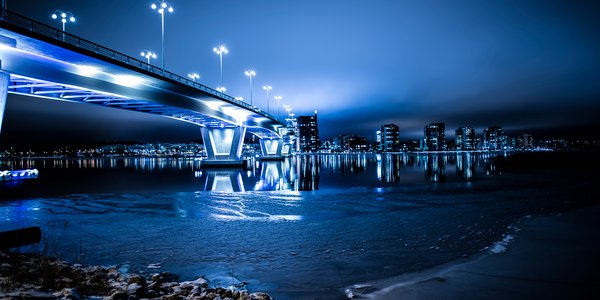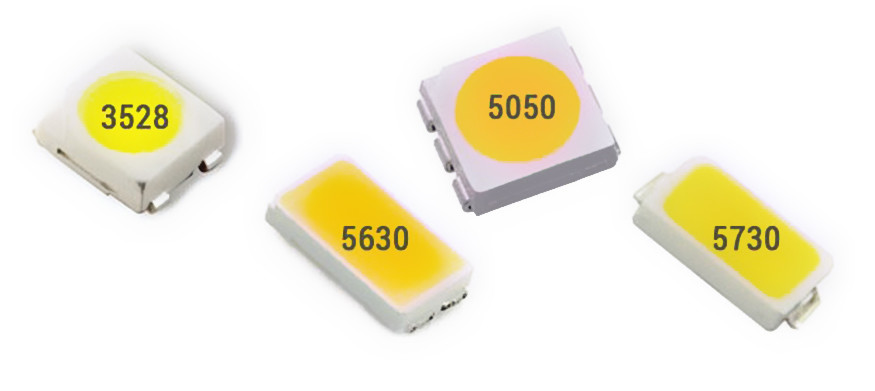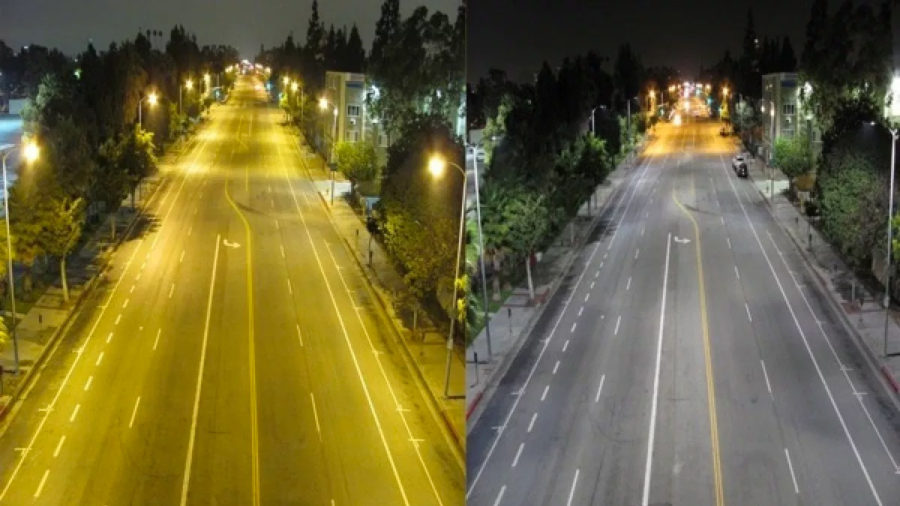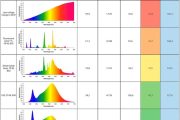Light
Knowledge of Light
Light travels in the form of electromagnetic waves. The light source is an electromagnetic wave that can be felt by people’s eyes, and its wavelength range is 380nm-780nm (nm: nanometer, length unit 1nm=10-9 m). Those longer than 780nm are infrared, radio, etc., and those shorter than 380nm are ultraviolet, X-ray, cosmic rays, etc.
The visible light part is further divided into seven basic monochromatic lights: red light, yellow light, orange light, green light, cyan light, blue light, and purple light.
Light, like all other electromagnetic radiation, travels in a straight line at a speed of 300,000 kilometers per second in a vacuum. When light passes through a substance such as water or air, its propagation speed will slow down.
The ratio of the speed of light in vacuum to the speed in the medium is called the refractive index of the medium. At the interface of two media with different refractive indexes, incident light produces refraction and emission phenomena. In addition, light will scatter, diffuse reflection, diffuse transmission, etc. during the propagation process.
Unit of Measurement of Light:
(1) Luminous flux: The amount of light emitted by the light source per unit time is called luminous flux, the symbol is φ, and the unit is lumens (Lm). Luminous flux is the human eye’s evaluation of energy radiant flux.
(2) Light intensity: The luminous flux emitted by the light source in a unit solid angle in a given direction is defined as the light intensity of the light source in that direction. The symbol is I, the unit is candela (cd), I = dφ/d. The unit of light intensity is the basic unit of photometry.
(3) Illuminance, also called brightness: the number of luminous flux emitted by a unit projection surface of a light source in a certain direction in a unit solid angle. The symbol is E, E = dφ/ ds, the unit is Lx (lux), I lx = 1 Lm/m2.
(4) Luminous efficiency: refers to the ratio of the luminous flux emitted by a light source to the electric power P consumed by the light source.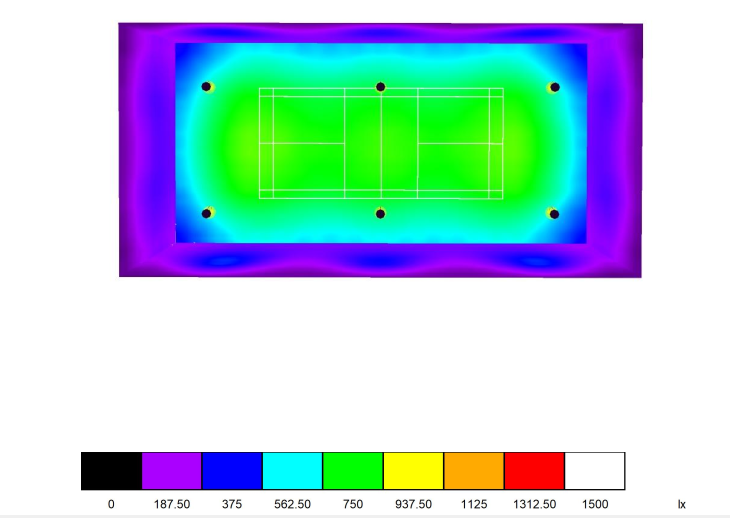
color
Knowledge of Color:
The human visual organs cause the brain’s psychological response in the color stimulus. That is, the visual organs are stimulated by light of different wavelengths, and at the same time, color stimulus signals are generated and transmitted to the brain. The brain continuously translates the color signals it receives into color concepts, and combines them with the visual experience stored in the brain to interpret them to form color perception.
Color is divided into colorful and achromatic. Achromatic colors refer to various shades of white and black. Colorful refers to various colors other than the black and white series.
Because of the emotional effect and the association of objective things, the visual stimulation of color produces a series of psychological effects of color perception. This effect varies with the specific time, location, and conditions (such as appearance and shape, natural conditions, personal hobbies, living habits, shape and size, and environmental location, etc.). Generally speaking, color can produce a sense of temperature, distance, weight, space, and darkness.
Color Temperature and Color Application:
(1) The Color Temperature of the Light Source:
People use the absolute temperature of a complete radiator that is equal to or similar to the color temperature of the light source to describe the color table of the light source (the color seen by the human eye when directly observing the light source), also known as the color temperature of the light source. Color temperature is expressed in absolute temperature K. Different color temperatures will cause people to have different emotional reactions. We generally divide the color temperature of the light source into three categories:
- Warm color light:
The color temperature of warm light is below 3300K. The warm color light is similar to the incandescent light, and the red light has more components, giving people a feeling of warmth, health and comfort. It is suitable for homes, residences, dormitories, hospitals, hotels and other places, or places with relatively low temperature.
- Warm white light:
Also called intermediate color, its color temperature is between 3300K-5300K. The warm white light is soft, making people feel happy, comfortable and peaceful. It is suitable for shops, hospitals, offices, restaurants, restaurants, waiting rooms and other places.
- Cool light:
Also called daylight color, its color temperature is above 5300K. The light source is close to natural light, it has a bright feeling and makes people concentrate. It is suitable for offices, meeting rooms, classrooms, drawing rooms, design rooms, library reading rooms, exhibition windows and other places.
(2) Color Rendering:
The degree to which the light source presents the color of an object is called color rendering, which is the degree of vividness of the color. Light sources with high color rendering have better color performance, and the colors we see are closer to natural colors. Light sources with low color rendering have poor color performance, and the color deviations we see are also large.
Why is there a difference in color rendering? The key lies in the spectral characteristics of the light. The wavelength of visible light is in the range of 380mm to 780mm, which is the range of red, orange, yellow, green, cyan, blue, and violet light that we see in the spectrum. If the proportion of the various colors contained in the light emitted by the light source is similar to that of natural light, the colors seen by our eyes will be more realistic.
We generally use the color rendering index to characterize color rendering. The standard color is set at 100 under the radiation of a standard light source. When the color standard is illuminated by the test light source, the degree of visual distortion of the color is the color rendering index of this light source. The larger the color rendering index, the less distortion. Conversely, the greater the distortion, the smaller the color rendering index.
Different places have different requirements for the color rendering index of the light source. In the International Lighting Association, the color rendering index is generally divided into five categories:
| Category | Ra | scope of application |
| 1A | >90 | Art galleries, museums and printing industries and places |
| 2B | 80~90 | Family, restaurants, advanced textile technology and similar industries |
| 2 | 60~80 | Office, school, outdoor street lighting |
| 3 | 40~60 | Heavy industry factories, outdoor street lighting |
| 4 | 20~40 | Outdoor road lighting and some places with low requirements |
light Source
Illumination light sources have different photoelectric characteristics due to their different lighting conditions. In order to select lighting sources correctly, it is necessary to understand their electrical characteristics, photoelectric characteristics and applicable occasions.
1. Classification of light source:
The classification of lighting sources is classified according to different forms of light emission. It can be divided into two categories: radiation source and gas discharge lighting source. The former uses electric current to pass through an electric wire to heat it to an incandescent state to emit visible light. The latter is to use the atoms of certain elements to be excited by electrons to generate radiation.
2, the choice of lighting source:
The selection of electric light sources should be based on the implementation of green lighting projects. The green lighting project aims to save energy and protect the environment. The specific content is: the use of high-efficiency, low-pollution electric light sources. Improve lighting quality and protect eyesight. Improve labor productivity and energy efficiency. To save energy, reduce lighting costs, reduce hydropower project construction, reduce the emission and escape of harmful substances, and achieve the purpose of protecting the human living environment.
(1) Restrict the application of ordinary incandescent lamps:
Ordinary incandescent lamps belong to the old generation of light sources with low luminous efficiency and short life span, which should be limited. But it can not be completely cancelled, because ordinary incandescent lamps have no electromagnetic interference and are easy to adjust, suitable for occasions that require frequent switching. It is an indispensable light source for local lighting, projection lighting, signal indication, mountainous areas and remote rural areas with abundant hydropower.
(2) Use halogen tungsten lamps to replace ordinary incandescent lamps:
Tungsten halogen lamps and general lighting incandescent lamps are both incandescent lamps. The uniform current is incandescent through the filament, which is an upgraded product of ordinary incandescent lamps.
The light effect and lifespan of halogen tungsten lamps are more than twice that of ordinary incandescent lamps. Therefore, in many lighting places such as commercial windows, exhibition halls (including exhibitions of general commercial products, cultural art and historical artifacts, etc.), and photographic lighting, etc., For occasions requiring high color rendering, high-end cold light or condensing light, various tungsten halogen lamps with different structures can be used to replace ordinary incandescent lamps to save energy and improve lighting quality.
Compared with compact fluorescent lamps, compact tungsten halogen lamps have relatively low efficacy and a relatively short lifespan. However, the disadvantage of compact fluorescent lamps is that the size of the luminous body is much larger than that of quartz tungsten halogen lamps of the same power, and it is difficult to achieve optical control of the output light.
Therefore, generally in the case of strict requirements on the beam output, a reflective compact tungsten halogen lamp is used. Compared with compact fluorescent lamps, compact tungsten halogen lamps also have the advantages of good color and easy dimming. In the absence of specific requirements, compact fluorescent lamps should be used as much as possible to replace incandescent lamps.
(3) Use LED lamps to replace incandescent lamps:
Compared with incandescent lamps, the luminous flux per watt produced by LED lamps is more than five times that of ordinary lighting incandescent lamps, and its rated life is 10 times that of incandescent lamps.
Due to the continuous improvement and improvement of the quality of LED lights, the color rendering index can reach more than 95. Under the general lighting situation, people can completely accept it with satisfaction. LED lights can also be connected with various fixtures to form an integrated light. There are various lamp holder designs, which can directly replace ordinary incandescent lamps, which is very convenient.
It is recommended to use φ26mm, φ16mm thin tube light LED tube light:
Replace the incandescent lamp with the φ26mm, φ16mm thin tube diameter LED lamp, and its luminous efficiency and lifespan are more than 6 times that of ordinary incandescent lamps. It is one of the best lamp types to replace ordinary incandescent lamps.
Fixtures
Fixtures is the general term for light sources, lampshades and accessories. In modern lighting, although the light source is the main one, the role of the lampshade is very important. The lampshade plays a role in fixing and protecting the light source, controlling and redistributing the light distribution in the space, and preventing glare.
1. Classification of lamps:
The variety of lamps is very rich, the appearance is ever-changing, and the performance is very different. The classification methods of lamps are also diverse, mainly including:
- According to the power supply used: divide the lamps into incandescent lamps, fluorescent lamps, high-pressure gas discharge lamps and LED lamps.
- According to the light distribution classification of the lamps: divide the lamps into five categories: direct lighting, full diffuse lighting, total reflection lighting, semi-indirect lighting and indirect lighting.
- Classification according to the installation situation of the building: divide the lamps into ceiling lamps, chandeliers, wall lamps, recessed lamps, foot lamps, courtyard lamps, automatic emergency lighting lamps, mobile lamps and road square lamps and so on.
- Classified by the place where the lamps are used: there are open lamps, closed lamps, sealed lamps, explosion-proof lamps, safety lamps and shock-proof lamps and so on.
2. Light distribution
The distribution of light intensity in space is an important characteristic of lamps, usually expressed by curves, so it is also called light distribution curve. There are generally three ways to express the light distribution curve: one is the polar coordinate method, the other is the rectangular coordinate method, and the third is the equal light intensity curve.
A. Polar coordinate light distribution curve:
On the metering plane passing through the center of the light source, the light intensity values of the lamps at different angles are measured. Starting from a certain direction, the light intensity of each angle is marked with a vector with the angle as a function, and the connection to the top of the vector is the polar coordinate light distribution curve of the lighting fixture.
If the luminaire has a rotationally symmetrical axis, only the light intensity distribution curve on a photometric surface passing through the axis can be used to illustrate the spatial distribution of its light intensity. If the light distribution of the luminaire is asymmetrical in space, the light intensity distribution curves of several photometric planes are needed to explain the spatial distribution of its light intensity.
B. Standard light curve:
For condensing lamps, because the beam is concentrated in a very narrow solid angle, it is difficult to express the spatial distribution of its light intensity in polar coordinates, so the right-angle light distribution curve representation method is used. The horizontal axis represents the light intensity map I, and the horizontal axis represents the projection angle of the beam. If it is a luminaire with a symmetrical axis of rotation, only one light distribution curve is needed. If it is an asymmetrical lamp, multiple light distribution curves are required.
C. Light intensity curve chart:
The curve connecting the top ends of the vectors with equal light intensity is called the equal light intensity curve. Arrange the values of adjacent waiting light intensity curves in a certain proportion, and draw a series of graphs composed of equal light intensity curves called waiting light intensity graphs. Commonly used diagrams include circular network diagrams, rectangular network diagrams and positive arc network diagrams. Since the rectangular network diagram can not only explain the light intensity distribution of the lamps, but also the regional distribution of the light quantity, the current isoluminous intensity curve diagrams used by the current projection lamps are all rectangular network diagrams.

